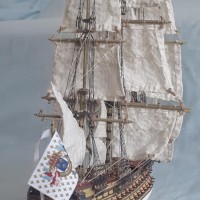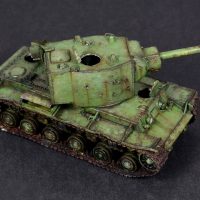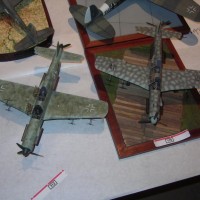Hasegawa 1/72 E7K1 with added catapult
Background
The Kawanishi E7K grew out of an Imperial Japanese Navy requirement for a replacement for the Kawanishi E5K observation seaplane. The Kawanishi Type 94 was the result (the designation E7K1 was a later application). Kawanishi came up with a three seater seaplane powered by a Hiro 91 W-type inline liquid cooled engine in 1933. After winning a competition against the Aichi AB-6 it entered service early in 1935. The Type 94 proved popular with its crews - it was robust and manoeuverable and withstood the rigours of sea service well. It was however, underpowered and the early Hiro 91 was somewhat unreliable. The addition of a 4 bladed propeller in place of the origninal 2 bladed unit and a more powerful Hiro 91 didn't solve the unreliability issues and it was only with the re-engining of the E7K with a Mitsubishi Zuisei 11 radial engine (becoming the E7K2 Type 94 Reconnaissance Seaplane Model 2) that these issues were solved. The earlier E7K1s served faithfully until replaced by the E7K2s and were then allocated to second line squadrons at the outbreak of the Pacific War.
The Model
This is one of Hasegawa's older kits and is in many ways quite crude and has been superseded by a more expensive and detailed AVI series. It would have probably disappeared except that Hasagawa decided to offer it with a model warship catapult. The kit has been reboxed several times with different decals and the Hasegawa catapult is also offered with their E13A1 model. The catapult trolleys for these models are different so one can't swap them between models but the catapult itself is a very welcome accessory. I believe it was originally a Fujimi model which could be obtained separately.
My boxing was an older boxing and the catapult whilst nicely detailed was accompanied by a kit covered in flash. On both models one has to be prepared to deal with ejector flaws which are in some places very visible and quite extensive. The decals are nice but old and took a lot of effort to get off the backing sheet (2 to 3 days soaking). Even after adding a lot of decal film they broke up easily and needed a lot of touch up. Why did I buy this model? It was very cheap, it had a catapult and it is the only extant model of the earliest E7K1s.
Building the model
Once it was cleaned up I started on the catapult first. The instructions are a bit vague and careful dry fitting is necessary to assemble it correctly. The ejector marks were filled and the catapult painted with Tamiya XF-91 Yokosuka grey. For the catapult wire I used a braided plastic wire I found in a DIY store which was cheap, steel grey in colour and came in 0.5 mm diameters. The stuff responded well to superglue and adds to the finished item. The E7K1 is a typical Hasegawa early production representing several different models rolled into one. It has the observer's sliding windows which were deleted on the later E7K1s but an incorrect 4 bladed propeller. Like the British, the Japanese initially created four bladed propellers by superimposing two two bladed units on top of each other at right angles to each other. I removed two blades to create the earlier propeller. The detail on the floats was sanded off (it was overscale anyway) and new detail added. The fuselage was left as it was as the raised panel lines were very representative of the fabric finish.
Of course, the kit cockpit was practically non-existent - this was early Hasegawa after all. I fabricated a new one based on drawings and photos. Other details added were SBS venturi tubes, tie down eyes and replacement glazing. Metal parts were painted Tamiya XF-16 flat aluminium and fabric parts X-11 chrome silver all satin varnished. For the aircraft I chose the Yo-115 option based at Yokosuka Naval base in 1935. I did replace the roundels with Techmod examples and hand painted the float warning stripes. Despite its age the kit went together well with only the exhausts proving troublesome. Extra pipework needed adding to them. The oil cooler was a discarded Letov Š-16 part which was far better than the kit version. Once it was finished the aircraft model was glued to the catapult.
Conclusion
This kit needs a lot of improvement to bring it up to current standards and is only really worthwhile because of the catapult and the fact it can be had very cheaply. Hasegawa continue to issue the model but really unless you want the particular decal options the current release offers it is worthwhile looking for a second hand example. They aren't expensive. The AVI kit is far better except, probably, for fit but is much more pricey. Rising decals offer a resin beaching trolley which is not one of the better bits of resin molding out there but is possible to make into a decent model. In the end with a lot of effort the Hasegawa kit looks the part especially sitting on its catapult. It's a surprisingly nice model to have in your display cabinet.









Despite being a difficult kit, you really build a wonderful seaplane, Christopher @christopher
The catapult is a really nice addition.
Thanks ever so much John (@johnb) - I'm very happy with this model. It does produce a very nice result.
That is very cool!
Thanks ever so much Rob - I agree it does look good when finished.
Very nice result - the catapult makes the whole thing work!
Hi Chas
Thanks!
The catapult is the better model - if only Hasegawa would bring the aircraft up to the same standard.
Fantastic result on a most challenging kit, Christopher!
Congratulations!
Many, many thanks Spiros. I now move onto something a bit easier.
Nicely done Christopher.
Thanks ever so much Alan.
Great work! I'm a big fan of Japanese float planes, especially the bi-wing variety. I build one of these (K1 with the 4-blade prop), and enjoy having it in my cabinet. I had similar issues with decals, though not as severe, and had to re-print a few myself to salvage them.
Thanks ever so much for the kind comments. My version is the same as yours but I converted the prop.